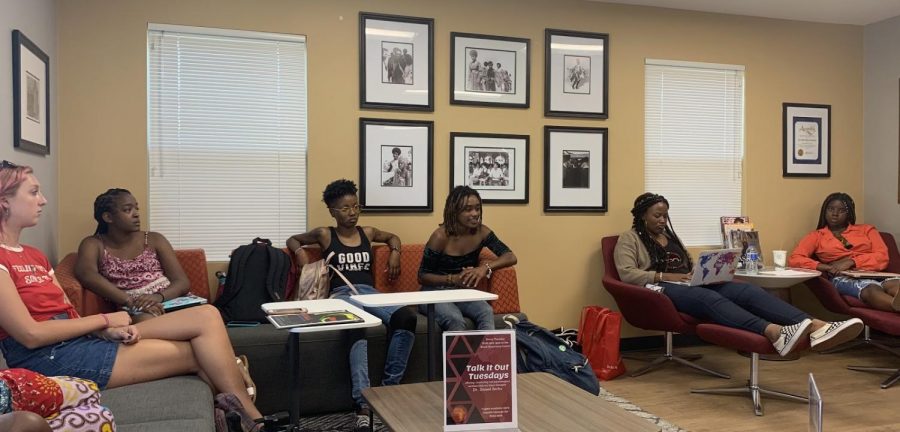After San Diego State was forced to notify students of an off-campus robbery that occurred last week, the Black Resource Center held a debrief on Monday, Sept. 23 to discuss racial descriptions in crime reporting.
The crime bulletin was sent to SDSU students on Thursday, Sept. 19 in a campus-wide email. All three suspects were identified as black males between the ages of 20 and 25 years old.
Psychology senior Darren Wilson serves as the coordinator for the Afrikan Student Excellence Council, which oversees the 17 black organizations on campus. Wilson led the meeting and explained the importance of clarity in reporting.
“I read the reporting policy and (the university does) have to talk about age range, gender, race/ethnicity, body type and/or height and two articles of clothing,” Wilson said. “In (last week’s report), the height and body type was missing for two out of the three suspects. Height and body type is a huge distinguisher between suspects, so that is definitely something that needs to be a criteria.”
Last October, university police collaborated with the office of Faculty Diversity and Inclusion to implement changes to the way the department reports racial descriptions of suspects. Most significantly, the new protocol requires a more detailed description of the suspect for their race to be relevant.
“The race of the suspect will not be released unless there is enough identifiable information to distinguish the suspect from our students, faculty and staff of color,” the email said.
The changes came after a suspect description sent by campus police left uncertainty about almost all of the suspects’ identifiable attributes — aside from their race.
“Victims and witnesses described the suspects as tall, thin Black male adults in their early 20s, wearing hooded sweatshirts. A more complete description was not available,” the 2018 safety notification said.
But the decision to include certain information in suspect descriptions is not always the university’s choice. Community safety notifications sent by Associate Vice President of Administration Jessica Rentto follow SDSUPD’s suspect description policy, whereas timely warning bulletins like those sent on Sept. 19 must follow very specific federal guidelines.
The Jeanne Clery Act, which applies to only some campus crimes, requires the police to disclose information and any known descriptors that impact their community, even if this does not comply with SDSUPD’s own suspect description policy.
In anticipation of the confusion that might be caused by issuing different kinds of safety notifications, a note was placed at the bottom of Thursday’s crime bulletin explaining why the notification did not follow SDSUPD’s suspect reporting policy.
University police spokeswoman Raquel Herriott said the degree of timeliness required for these notifications can be restricting when trying to get more thorough suspect descriptions.
“For the most part, for a timely warning crime bulletin or a Clery-required emergency text message notification, we are required to send out any known descriptors and we will do our due diligence to try and get as much information as possible,” Herriott said. “We still have to ensure that we’re being timely.”
Wilson’s assessment of the campus-wide email sent on Sept. 19 accurately states that two of the three descriptions on the email don’t include details on the suspects’ height or body type. This is due to the fact that the notification fell under the Jeanne Clery Act, which requires this information to be disclosed regardless of its missing components.
But Wilson said it is these kinds of vague suspect descriptions that put the black community at risk.
“They described the suspect as a black male, 20-25 years old,” Wilson said. “That was very concerning for many members of the black community, as it put all black males at the university at risk, and that leads to racial profiling.”
Africana studies junior and Afrikan Student Excellence Center chair Tamiel McKee Bey said the constant warning about “black males” leaves far too many questions unanswered.
“It was very unclear who exactly was involved and whether or not those were the actual individuals who were involved,” she said. “I did a search of my Gmail from previous bulletins. All of the bulletins I have from SDSU are of black males being suspects. There is not another suspect identified since 2018 other than black males.”
McKee Bey said she felt enraged in large part because she saw five to 10 black males on campus who were wearing all black and who could have fit the descriptions sent to by university police.
“I have two young black brothers, and one of them fit the description perfectly,” she said. “In my head all I could see was my brother being pinned down to the ground and then eventually a bullet being put in his head, simply because he fit the description.”
Attendees at the debrief recommended university police take workshops on different cultures, better learn their surrounding communities and make more consistent appearances at the Black Resource Center’s programming.
As things are now, McKee Bey said SDSUPD has got a lot of work to do.
“Starting today I think they (SDSUPD) should start making more eye contact with black students on campus,” McKee Bey said. “Why am I walking past you, smiling at you, and you have nothing in return but a scolding look.”
News Editor Kaitlyn Little and Editor in Chief Bella Ross contributed to this story.







